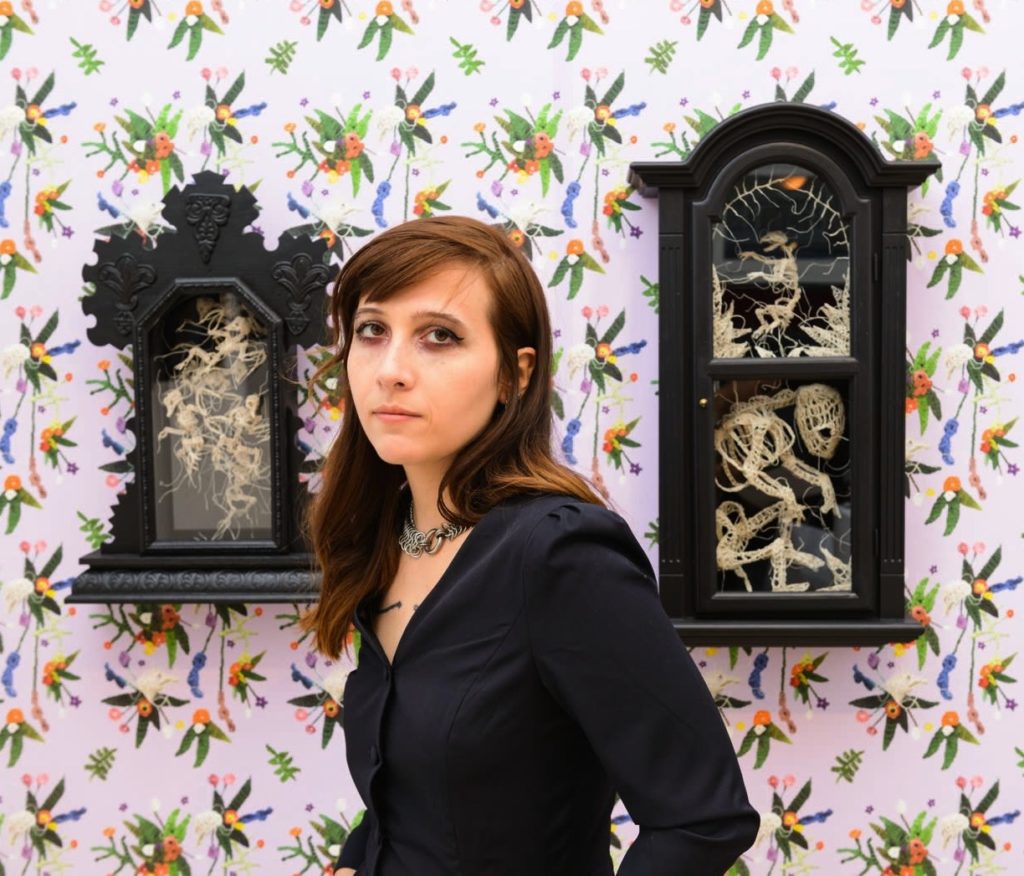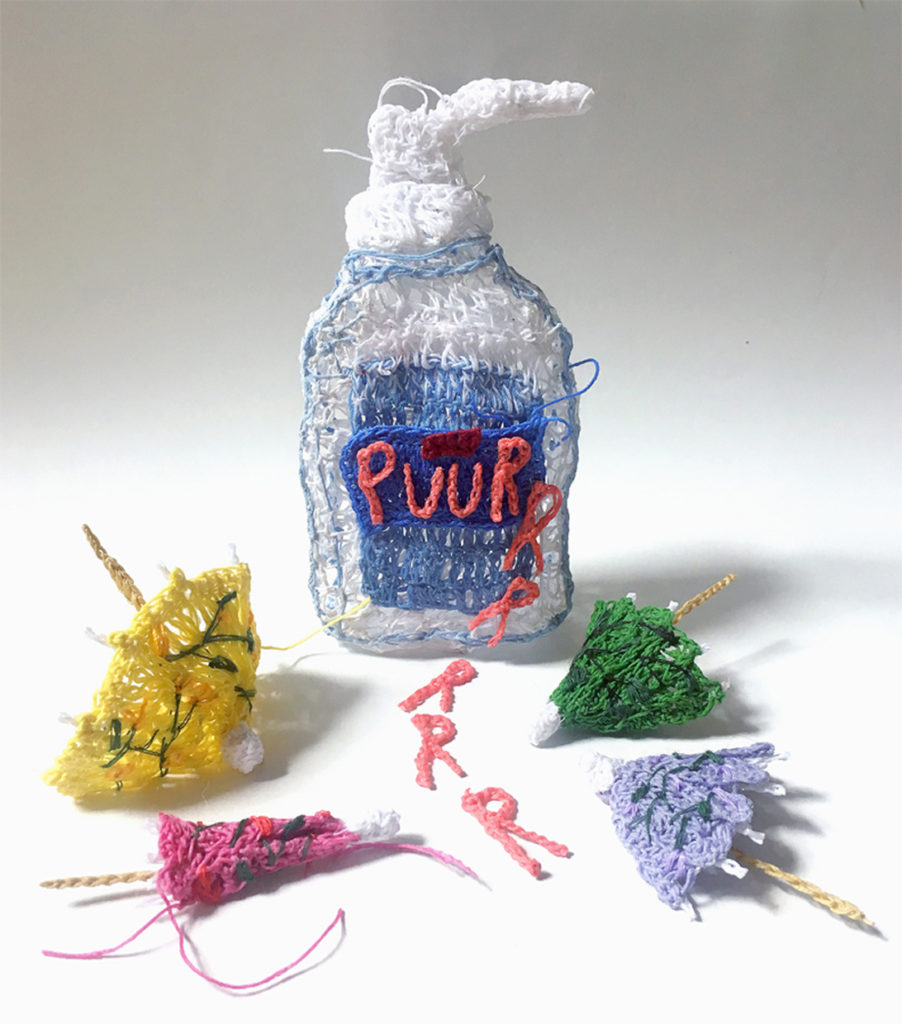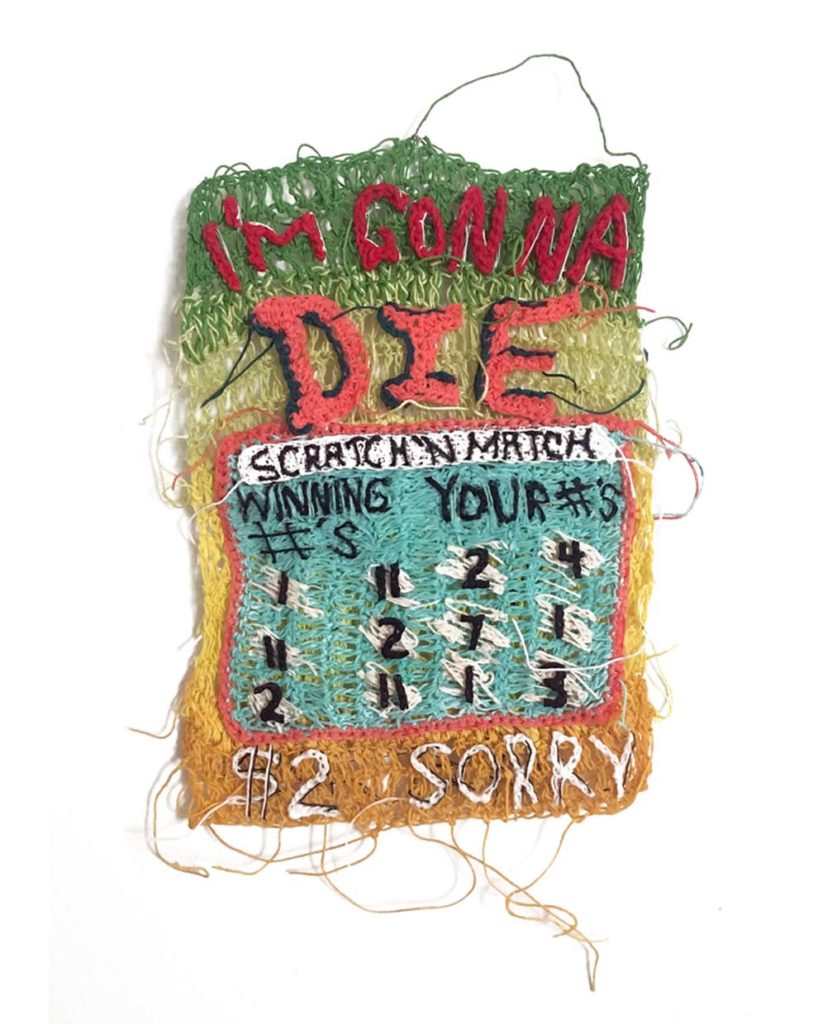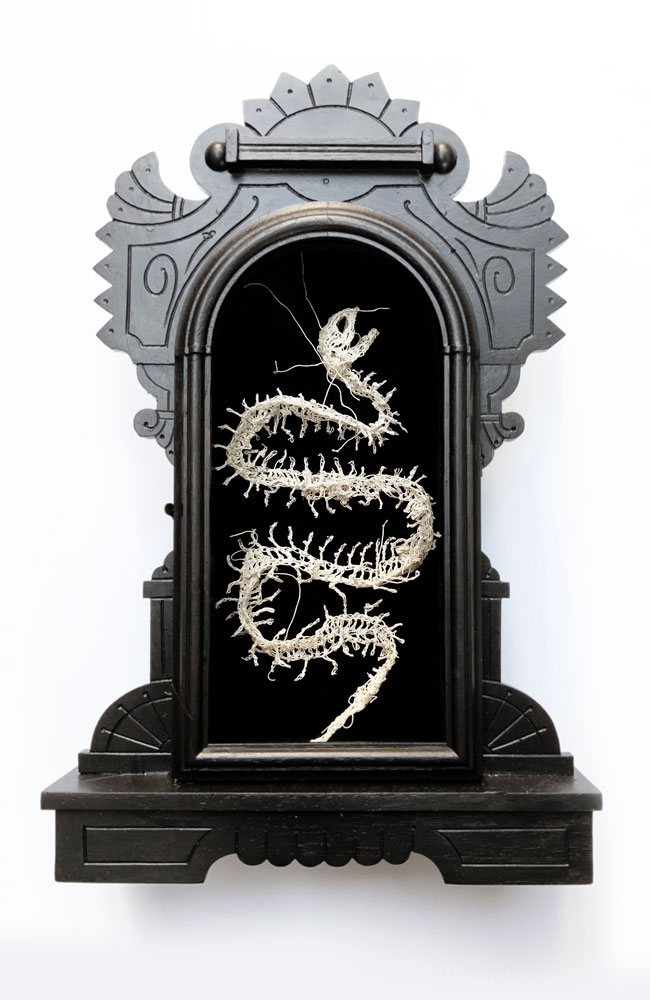
In The Giver, Lois Lowry wrote, “The worst part of holding the memories is not the pain. It’s the loneliness of it. Memories need to be shared.”
Mixed media artist Caitlin McCormack has dedicated her artistic career to sharing memories as a way to connect. She first experimented with her unique blend of crochet and glue stiffeners to navigate personal grief and honor the memories she had of her grandparents.
In her series of crocheted animal skeletons, the delicate and breathtaking forms she creates instantly remind the viewer of nature and bone though they are neither anatomically precise nor made of skeletal material. Her latest work explores how discarded or obsolete inanimate objects are tied to memory and nostalgia.
Caitlin’s deft and relatable treatment of such an ephemeral concept as memory gives her work great emotional resonance.
With the ever-present knowledge that we are living through something historic, I’ve been thinking a lot about memory. There is a lot of quiet time to reflect on the memories I’ve made over the years. But there’s also the concern that I, as a writer, document these times in a way that honors what we are experiencing. Preoccupied with the concept of memories, I reached out to Caitlin to see if she has been reflecting on the subject as well. Unsurprisingly, she has.
You live in Philadelphia, Pennsylvania. How has your daily life changed since the spread of Covid-19?
My gut response to this question is that, on the surface, my day to day life hasn’t really changed much.
I work full-time as an artist which means that I spend most of the day isolated in the studio, communicating with people online or over the phone, and going for long walks to break up my schedule.
I have to be much more careful during those walks, but a lot of my daily routine is the same.
In spite of that, everything feels very foreign because the world around me is in such a state of chaos, and people are suffering more than ever.

Has your creative process been affected during this time? Are you making art? If you are making art, what have you been working on?
My studio practice has been heavily flavored by what’s happening in the world, like I’ve been generating a lot of work in response to the pandemic.
In some ways, Covid-19 has helped me to condense my thoughts about isolation and nostalgia, things like that.
I’m currently working on a series of fiber sculptures of objects that are sort of warping into other things, like the identities of the objects are no longer tethered to their actual purpose, and their usefulness has grown entirely inscrutable.

I know you for your delicate mixed media animal skeletons, but you’ve recently been exploring the forms of inanimate objects such as disintegrated VHS tapes, a lottery ticket and a hand sanitizer bottle. What brought about this shift in focus? Have you felt compelled to shift away from the skeletons at this time of heightened mortality or were you already exploring other forms before the pandemic? And how does your inanimate object work fit into your work as a whole?
I have been wanting to deviate from the skeletal work for a long time, but have had a hard time doing so because that’s the type of work that sells and allows me to continue, you know, existing.
I guess I’m more apt to abandon that now because of a recent “if not now, when” sort of attitude.
That mentality might be what’s drawing me towards sort of nostalgic and foreboding subject matter, such as ominous VHS cassettes, because it’s terrifying. These objects, for me, are as much in the memento mori vein as the skeletons were, just less explicitly so.
Central to your work is the concept of memories. Not only do you create sculptures based on specific private memories, but you also manipulate how you use reference material so that you end up creating the memory of a skeleton instead of meticulously trying to recreate skeletons. Given how key memories are to your work, do you find yourself more conscious of how you process your experiences? Are you consciously trying to remember this historic moment?
That’s a really interesting question and it’s definitely something I dwell on quite a bit.
So much of what I do is hinged upon the idea of a memory warping and twisting further and further away from the truth, but if I’m deliberately proceeding through life with the intent to process memories in such a way, how can I be certain where or when the actual point of distortion occurs? Like, can I even produce an organic memory anymore, or was I ever able to do it? That has been on my mind.
I’m certainly trying to distill certain moments that spontaneously happen while in quarantine, to keep them in sort of a bank, saving them for later.
I put a lot of pressure on myself to try to make work about things that really affect me in a drastic way, which is kind of stupid, because I should just let the subject matter come. I guess I’m not as concerned with that dumb shit as I used to be, and yet here I am, preserving Covid-19 memories in a hermetic chamber for yet-to-be-determined purposes at a later date.

Additionally, do you intend or expect to create pieces inspired by your memory of living through the pandemic? Have you thought at all about what form that totem might take?
I’m in the process of creating some works in that vein, to expand upon the series with the lottery ticket, exploring the isolating and uncertain experience of this period.
I also have some works depicting organisms interacting with various plants and rhizospheric debris, which simultaneously serve as memento mori and vibrant examinations of life, and are probably very much about the degree to which I miss being in nature. So many people are making work about the things they miss.
In an interview you did for Make:Community in 2016, you said, “I focus a lot on trauma and I want people that have had experiences like that, or have been affected by the experiences of others, to feel comforted.” Probably more than any other time in our lifetimes, people are going through a globally shared trauma. What is the role of art and the artist to make meaning from this trauma? And how can art comfort the suffering?
Deriving meaning from suffering and trauma is really tricky business, when it doesn’t pertain to your own specific experience (or even if it does), because it teeters on the precipice of insensitive exploitation, so I try my best to focus on commiseration when it comes to my work.
I think just being explicit about your suffering, demonstrating that you’re a vulnerable, human person, can really help others to contend with their own pain simply because they might not feel so alone as a result.
Anything that can help spread awareness about and normalize mental illness, especially right now when literally everyone is is some amount of despair, is worth doing.

You found your sculptural medium when you decided to combine crochet and animal sculpture to honor your grandparents after their passing. With loss all around us, do you have any perspective on processing grief?
I think that just allowing oneself to go run through the whole grief spectrum, without shame or feeling as though it will hurt too much or demonstrate too much human fragility, is the best way to contend with loss.
You can’t avoid it, it’s going to happen and will keep happening, so finding ways to be gentle and patient with yourself is key.
For some people, this might manifest as an urge to take time and watch a bunch of movies while eating Funyons, and for others it might entail some huge, ambitious undertaking (no pun intended).
There’s nothing wrong with being ambitious, and venturing in the opposite direction is totally acceptable, too. I happen to deal with grief by immersing myself in repetitive creative endeavors, and can’t recommend it enough.
Personally, in a period following a great personal loss I spent several days knitting a very bulky sweater only to unravel the whole thing when I reached the end. It was a cathartic, tear-soaked experience that still gives me chills when I look back on it. You’ve similarly found comfort in the repetitive motion of crocheting. What advice would you give people about hand crafting as art therapy during this period?
Any sort of repetitive, creative practice involving your hands has the potential to help one transcend into a meditative state. It can just be a period of intense focus, or something more spiritual, if that’s your bag.
My thoughts on accessing that sort of state through creative processes such as crochet are that if you’re going to meditate, which we probably all should in some way, shape or form, you might as well come out of it with a sweater or even just, like, the knowledge required to make one.
Also, it feels really good to work with your hands when you’re going through some shit – you can purge yourself of some of that pain by imbuing the material running through your fingers with your suffering, trapping it there in the yardage and cutting it loose.
So much of your work depicts animal forms. With suspicions that the spread of Covid 19 can be traced to wildlife trading and possibly consumption, as well as the confirmation that cats both domestic and large have tested positive for Covid 19, what are your thoughts on humankind’s responsibilities to the animal kingdom at this time?
I just watched the Sopranos, and there’s a part where Tony’s psychiatrist is reading up on the narcissistic criminal mind and how oftentimes compulsive criminals value animal lives more than the lives of humans, or something like that. This, along with a few other details, compels her to reconsider continuing to help him as a patient.
I don’t really know why I’m bringing this up – I guess it reminded me of myself a little bit, which isn’t so great because Tony Soprano is a bad guy. I definitely prefer animals to humans (not that I don’t value human lives, because of course I do).
We obviously, desperately need to drastically improve the way we care for the planet and its inhabitants, more than ever, without a doubt. These concerns extend incredibly far beyond Covid-19.
I hope that present conditions will help some people wake the hell up and start caring about animal welfare. I don’t even know what to say about the bat thing. Everything is insane.

You have a penchant for placing your skeleton forms in antique clock cases. Obviously there’s a strong connection between memory and time, but how and why did you start seeking these clock cases out?
I was actually given one of those clock cases many years ago and wasn’t quite sure what to do with it, which eventually lead to the idea to use it as a shadow box.
Gingerbread clock cases usually have a really nice amount of depth, and have a beautifully imperfect, handmade quality.
I love the idea of coming into the possession of objects or materials and keeping them for a really long time before the revelatory decision to use them arrives out of thin air. That’s always a really cool feeling.
Are there any supplies or tools that you rely on or would like to have but are currently struggling to get?
I’m lucky that my studio is pretty well-stocked at the moment, although I don’t know how I’m going to get frames when I need them.
I’m running low of a product called “Stiffy” which I initially bought in college because it reminded me of boners, but wound up using pretty regularly. I’m going to have to get pretty creative in a lot of ways. We all are.
What kind of art have you been consuming and why? Is this different than what you typically consume?
I would say that I’ve primarily been watching a lot of weird videos, but that’s sort of a consistent part of my life.
Film is one of my favorite art forms, as is comedy, and my brain needs them both more than ever right now. They’re not the weirdest or obscure thing to mention, but when I’m feeling disjointed or out of sorts, I always watch a ton of Tim and Eric clips and shows. I feel pretty confident saying that they’re my favorite artists.
Did you have any planned showcases that have been postponed or canceled? Or were there any shows that you were looking forward to attending?
I’m a pretty solid introvert, but attending opening receptions served as a major source of social interaction and I really miss the ritual of seeing friends and peers at openings.
I had a few group shows transition from IRL to online territory (it feels weird to use internet parlance to describe something that wasn’t supposed to happen online in the first place, yet here we are).
I’m in HERE AND NOW, a group exhibition at the Fort Wayne Museum of Art in Fort Wayne, IN, curated by Ken Harman of Hashimoto Contemporary, which I was really hoping to try to see. Luckily the end date has been extended until August 30.
I have a mural project in Philadelphia, which has been postponed indefinitely.
I’m happy to say that my show with Allison Sommers at Talon Gallery in Portland, OR, is still scheduled to take place in December. I’m looking forward to that.

You’ve applied for a small artist support grant through iLYSM. What financial resources are out there for artists struggling during this time (other than the discarded lottery scratch off tickets you’ve observed littering the sidewalks)? What more needs to be done?
There are a lot of micro grants floating around right now that can be of assistance to struggling artists.
I’m having a hard time contending with the grant situation because I’m too much of a disaster of a person to put together a real knockout of a grant application, right now. I can and will try my best, but I feel as though an artist who has their shit together emotionally will be more likely to receive funding.
Maybe that’s just my life-long negativity taking the wheel, but it’s really hard to be positive about this stuff right now.
In a perfect world, the arts and artists would be funded in a way more all-encompassing and generous manner.
There are definitely some organizations out there promoting the notion that art is essential, including iLYSM.
If you’re trying to get funding, I suggest Googling what programs are available in your state or city and putting together a stellar selection of your best images, and just being honest about your situation.
What can we do to support your work at this time?
It’s really kind of you to ask about that. I feel really uncomfortable and strange telling people that they should buy my work or order commissions right now, but that is the most effective way to help me sustain my career and my life at this time or, hell, at any time.
I’m trying to work with clients’ budgets during this difficult period, so if someone has had their eye on my work for a while, they should definitely feel free to reach out.
Sharing it via social media, tying photocopies of my prints to arrows and shooting them blindly across town, and burning effigies of my body on my parents’ lawn while muttering arcane incantations are also really great ways to help.
Thank you Caitlin for your thoughtful responses.
To see more of Caitlin’s work, visit her website and follow her on Instagram.
Caitlin’s original artwork is available through Paradigm Gallery and Studio, InLiquid, Hashimoto Contemporary, Antler Gallery, and Mortal Machine Gallery. Pieces can also be commisioned via email.
You can also take a virtual tour of the group show Caitlin is in, HERE AND NOW, on Fort Wayne Museum of Art’s website.
*This post contains Amazon Affiliate Links. As an Amazon Associate I earn from qualifying purchases.
Dahlia Jane
Dahlia Jane is a wicked writer living in Los Angeles. She writes about the dark arts scene, goth life and fascinations with the macabre. Dahlia spends her free time obsessing about skulls, devouring true crime and occult books, sewing and making messes.